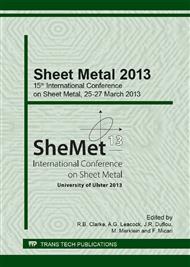p.270
p.277
p.284
p.295
p.302
p.311
p.317
p.325
p.333
Study on Formability Characteristics of the Weld Seam of Aluminum Steel Tailored Hybrid Blanks
Abstract:
Tailor Welded Blanks (TWB) are characterized by the fact that sheets with different material qualities and/or thicknesses are welded together before the forming process. The application of TWBs in the automobile industry brings several advantages, such as the reduction of car body weight and manufacturing costs, as well as the integration of several drawing parts into one part. Despite several established tailor welded blanks types, a new version has emerged: The Tailored Hybrid Blanks (THB). The current investigation focuses on tailored hybrid blanks joined by the CMT-welding technology. The main aim of this study is to specify the mechanical properties as well as the formability of Aluminum Steel Tailored Blanks. Steel (HX340LAD, 0.8 mm) sheets covered by different zinc coat thicknesses were combined with an aluminum alloy (AA6014-T4, 1.2 mm). In order to determine the material properties and to analyze the Heat Affected Zone (HAZ), microhardness measurements were taken transversal and longitudinal to the weld line. Results indicate a change of hardness and a very small HAZ. Tensile tests (perpendicular to weld line) and Nakajima tests with online deformation analyses show that the main formation takes place on the aluminum side.
Info:
Periodical:
Pages:
302-310
Citation:
Online since:
April 2013
Authors:
Price:
Сopyright:
© 2013 Trans Tech Publications Ltd. All Rights Reserved
Share:
Citation:


